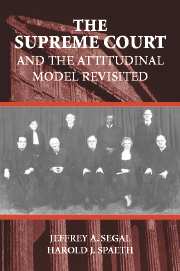Book contents
- Frontmatter
- Contents
- List of Illustrations
- List of Tables
- Preface
- 1 Introduction: Supreme Court Policy Making
- 2 Models of Decision Making: The Legal Model
- 3 Models of Decision Making: The Attitudinal and Rational Choice Models
- 4 A Political History of the Supreme Court
- 5 Staffing the Court
- 6 Getting into Court
- 7 The Decision on the Merits: The Legal Model
- 8 The Decision on the Merits: The Attitudinal and Rational Choice Models
- 9 Opinion Assignment and Opinion Coalitions
- 10 The Supreme Court and Constitutional Democracy
- 11 Conclusion
- Case Index
- General Index
7 - The Decision on the Merits: The Legal Model
Published online by Cambridge University Press: 05 June 2012
- Frontmatter
- Contents
- List of Illustrations
- List of Tables
- Preface
- 1 Introduction: Supreme Court Policy Making
- 2 Models of Decision Making: The Legal Model
- 3 Models of Decision Making: The Attitudinal and Rational Choice Models
- 4 A Political History of the Supreme Court
- 5 Staffing the Court
- 6 Getting into Court
- 7 The Decision on the Merits: The Legal Model
- 8 The Decision on the Merits: The Attitudinal and Rational Choice Models
- 9 Opinion Assignment and Opinion Coalitions
- 10 The Supreme Court and Constitutional Democracy
- 11 Conclusion
- Case Index
- General Index
Summary
Chapters 7 and 8 begin where Chapter 6 left off: with the considerations that apply once the Court has agreed to hear a litigant's case. Accordingly, we start with a discussion of the stages that follow the decision to decide a case and the considerations that govern the disposition of these cases. We especially emphasize the legal and political factors that affect the justices' decisions. In this chapter we focus on the process of deciding cases and the influence of legal factors; in the next chapter we focus on the attitudinal and rational choice explanations.
PROCESS
Cases that receive full treatment from the Court – that is, those that are orally argued and decided with a full opinion (which are also referred to as formally decided cases) – are typically subject to three votes. We considered the first of these – the decision to decide – in the previous chapter. If the Court votes to grant cert or to note probable jurisdiction, the other two votes occur following oral argument. These are the original vote on the merits and the final vote on the merits. Palmer refers to them more accurately and descriptively as “conference votes on the merits” and “report votes on the merits. We know relatively little about the former vote, a great deal about the latter. First, though, we present a discussion of oral argument.
Oral Argument
Oral argument is the only publicly visible stage of the Court's decisionmaking process. The extent to which it affects the justices' votes is problematic.
- Type
- Chapter
- Information
- The Supreme Court and the Attitudinal Model Revisited , pp. 279 - 311Publisher: Cambridge University PressPrint publication year: 2002



